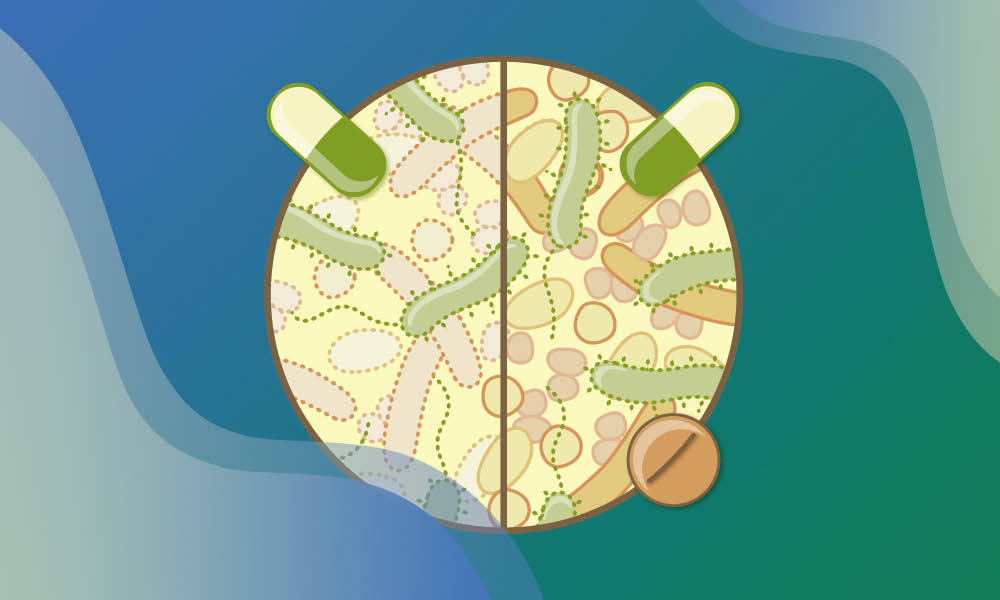Understanding microbial functions and interactions for the benefit of human and planetary health

By Nassos Typas, Peer Bork, Michael Zimmermann, Maria Zimmermann-Kogadeeva, Rob Finn
We live on a planet of microbes. Our microscopic fellow travellers colonised Earth long before oxygen appeared in its atmosphere and are the reason we have oxygen on this planet. Although microbes are usually unicellular organisms, they regularly form communities with members of the same and different species. EMBL scientists have been studying microbiomes - the collection of all the microbes in a specific habitat - for two decades, providing key insights into antimicrobial resistance, cancer, ocean biodiversity, and more.
Microbiome studies started at EMBL as early as 2003, with the first comparative study between habitats appearing in 2005. EMBL has been a pioneer in human microbiome studies, playing a crucial role in the first EU microbiome grant in 2008 and hosting the founding of the International Human Microbiome Consortium (IHMC) in Heidelberg in the same year. EMBL led the microbiome analysis in the Tara Oceans consortium, which published its first results in a special issue of the journal Science in 2015. Since the late 2010s, EMBL has also been leading experimental studies on the human microbiome, knowledge that has culminated in the establishment of a new Microbial Automation and Culturomics Core Facility in 2024. In the last decade, microbiome research has flourished in various groups across EMBL sites, tightly interacting with each other.
Today, using molecular and computational tools, we can study microbiomes as well as their interplay with the environment in which they are found in unprecedented detail. The understanding we gain has important relevance for the way we diagnose and treat disease and assess and protect ecosystem health on our planet. EMBL scientists today apply computational, statistical and mathematical tools, as well as experimental approaches, such as high-throughput culturing and genetic screens, to better understand the functional interplay of microbial ecosystems - from the human gut to European soils.
Recent studies from EMBL have shown, for example, how antibiotics as well as other common drugs affect the gut microbiome and how these microbes store and chemically alter these drugs, influencing their effectiveness. Interestingly, some of these effects of medication on gut microbiome composition can be passed from fathers to their offspring. EMBL scientists are also studying how the gut microbiome can affect physiological processes such as immunity, reproduction, and even cancer. Insights gained from these studies could hold clues to better therapeutic and diagnostic strategies as well as provide us with a richer understanding of how microbial species behave and interact in complex natural ecosystems. Such knowledge of microbes and how they impact their environment can also be used for interventions, both in terms of restoring planetary health and in improving disease outcomes.
Microbes from a variety of environments and contexts are studied at EMBL. For example, EMBL scientists have pioneered genome-wide genetics and proteomics approaches to study gene function, the mode-of-action of antimicrobial drugs, and how pathogens can inject toxic effectors in the host and hijack the host cell from the inside. Research on enigmatic genes encoded in bacterial genomes has unravelled new mechanisms of internal suicidal mechanisms that bacteria possess and how some of them contribute to immunity against infecting viruses, opening new doors for fighting bacterial pathogens. EMBL groups also work on a wide variety of environmental microbes, studying, for example, how soil microbes form collectives and interact with protozoan predators, how marine eukaryotic and prokaryotic microbe symbiosis affects their development and their environment, how archaea package their genomes, and how microbes living in extreme environments can take care of toxic metals and pesticides.
At the same time, EMBL's data services, such as the metagenomics data services (MGnify and SPIRE) and the European Nucleotide Archive not only advance EMBL's own work but also enable microbiome research worldwide. Our computational groups have pioneered efforts to recover genomes from metagenomics datasets, spanning viruses, archaea, bacteria and single-cell eukaryotes. For example, studies on the human gut and skin have provided unprecedented insights into the human microbiome, yielding information on novel species and demonstrating the compositional variability of the microbiome at different body sites. Such studies often involve extensive collaborations to generate the data, as well as to culture and sequence microbes to validate the computational findings.
More broadly, we have applied these computational approaches to tens of thousands of datasets collected across the world to identify millions of genomes associated with a wide range of host organisms and environments. Microbes have the highest functional capacity on this planet, with almost every commonly used molecular biology tool and many of the natural products used in medicines coming from them. Using these vast catalogues, and combining them with both experimental and data-mining-based approaches, EMBL researchers are trying to harness this huge capacity for novel functions, e.g. to aid the discovery of enzymes or the identification of biomarkers that may be indicators of diseases or environmental change.
EMBL continues to build on its strengths in this area, from taking microbiome research into the context of the environment with the TREC expedition to nurturing clinical collaborations to leverage microbiomes for improved human health, to developing new technologies to quantify and visualise microbial life in context, to establishing new high-throughput and automated experimental setups to study diverse microbiomes. The next 50 years of microbiome research will be exciting!






